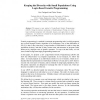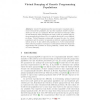151 search results - page 3 / 31 » Seeding Genetic Programming Populations |
GECCO
2006
Springer
13 years 9 months ago
2006
Springer
The population size in evolutionary computation is a significant parameter affecting computational effort and the ability to successfully evolve solutions. We find that population...
GECCO
2004
Springer
13 years 11 months ago
2004
Springer
We present a new method of Logic-Based Genetic Programming (LBGP). Using the intrinsic mechanism of backtracking in Prolog, we utilize large individual programs with redundant clau...
GECCO
2003
Springer
13 years 11 months ago
2003
Springer
With the exception of a small body of adaptive-parameter literature, evolutionary computation has traditionally favored keeping the population size constant through the course of t...
BMCBI
2008
13 years 6 months ago
2008
Background: Modern proteomes evolved by modification of pre-existing ones. It is extremely important to comparative biology that related proteins be identified as members of the s...
GECCO
2004
Springer
13 years 11 months ago
2004
Springer
Abstract. Genetic Programming often uses excessive computational resources because the population size and the maximum number of generations per run are not optimized. We have deve...


